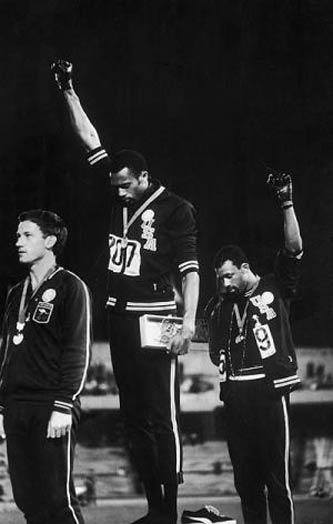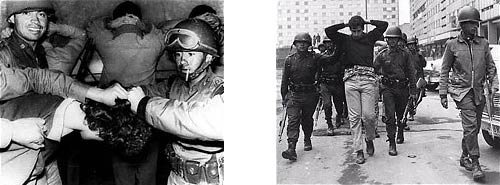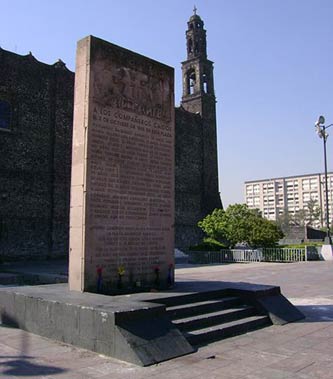A brief history of Olympic dissent: Mexico 1968
To coincide with today's opening ceremony in Beijing, over the last few days I've been writing a series of posts looking at the political controversies, protest and dissent that has often surrounded the Olympic Games since their modern foundation in 1896. Some, like the student prank of a fake Olympic torch in Sydney for the 1956 games were funny. Others, like Peter O'Connor's protest at having to compete as an Irishman under the British flag, or Stamata Revithi's marathon run to show that women could compete in the Games, had a more serious message.
From 1968 onwards however, the Olympic Games were plunged into nearly two decades of crisis caused by a succession of major demonstrations, protests, boycotts and a deadly terrorist attack. Today I wanted to look at three protests that took place at the 1968 Mexico Olympics.

Tommie Smith and John Carlos
"It is very discouraging to be in a team with white athletes. On the track you are Tommie Smith, the fastest man in the world, but once you are in the dressing rooms you are nothing more than a dirty Negro." - Tommie Smith

The clenched fist and Black Power salutes of Tommie Smith and John Carlos on the medal podium have become the defining image of the Mexico Olympics. It nearly didn't happen, because earlier in the year there had been a movement amongst African-American athletes calling for a boycott of the Games due to the continual racial discrimination that athletes suffered in the USA.
"It was in my head the whole year. We first tried to have a boycott but not everyone was down with that plan. A lot of athletes thought that winning medals would supercede or protect them from racism. But even if you won the medal, it ain't going to save your momma. It ain't going to save your sister or children. It might give you fifteen minutes of fame, but what about the rest of your life? I'm not saying that they didn't have the right to follow their dreams, but to me the medal was nothing but the carrot on a stick." - Tommie Smith
It seems that the two men are barely on speaking terms 40 years later, having spent most of the intervening years having their lives reduced to one powerful image. And it may have saved Tommie Smith's life - he was discharged from army service as a result of his 'un-American activities', which prevented him being sent to Vietnam. Two brothers of John Carlos were also sent home from battle.
Sadly, as with Jesse Owens in 1936, the controversy surrounding the racial politics at the Olympics has over-shadowed the athletic achievements of the men involved. There is some archive programming of coverage from 1968 available on the CBS site, and this YouTube clip shows by just how far Tommie Smith won his gold medal from Peter Norman of Australia.
Peter Norman also faced controversy when he got back home to Australia, where he was criticised for wearing the same 'Olympic Project for Human Rights' badge on the podium as Smith and Carlos did. Despite running the necessary qualifying times, he was excluded from the Australian squad which went to the 1972 Olympics, and he was not invited to take any part in the 2000 Sydney Olympic celebrations by the Australian organisers. Carlos and Smith both went to Norman's funeral in 2006 and delivered eulogies to the late sprinter, who still holds the Australian record for 200 metres which he set in that Mexico final.
If you look at the comments on YouTube underneath that clip, you'll see that the issue of whether Smith and Carlos were right to protest or were being disrespectful to their country is as divisive as ever, but rather than leave the last word to some kids on YouTube, I'd rather give it to John Carlos:
"When we arrived at the award stand there was a lot of applause. When we left there were many boos and thumbs down. Well, John Carlos and Tommie Smith want the people who booed to know that black people are not lower animals like roaches and rats. ... We're not like some sort of a show horse who does its job and then had some peanuts tossed at it. We'd like to tell all white people that if they don't care for things black people do, they should not go see black people perform." - John Carlos, 1968
The Tlatelolco Massacre
Tommie Smith and John Carlos' protest was beamed worldwide and gained attention across the globe. It was peaceful, but earned the ire of the IOC. In contrast, a few days before the games began, Mexican authorities ended a student demonstration with violence, and the IOC shrugged their collective shoulders and said it was an 'internal matter' for Mexico. Indeed, these days, remembering the Tlatelolco Massacre also seems an internal matter for Mexico, as the iconographic image of Tommie Smith and John Carlos has tended to overshadow any recollection of the massacre.
There had been widespread unrest in Mexico leading up to the hosting of the Games. 1968 was a year of student uprising around the world, and many Mexicans thought that the money being spent on hosting the Olympics could be better spent on improving domestic living standards. Eventually, the authorities decided that the only way to suppress the protest was with a violent response.

On October 2nd, ten days before the games opened, army and police forces targeted a demonstration at the Plaza de las Tres Culturas. Estimates of the death toll vary between single figures and four figures, but the consensus seems to be that at least a couple of hundred people died. In the nineties a memorial featuring some of the names of those killed was placed in the square.

Věra Čáslavská
The official Olympics site tends to airbrush controversy from the history of the games. Their summary of 1968 makes no mention of either Tlatelolco or Tommie Smith and John Carlos. It does, however, describe Věra Čáslavská as the "most popular female athlete" of the Games.
Prior to the Olympics, the Soviet Union had invaded Czechoslakia, and Čáslavská, from Prague, had gone into hiding. She emerged to compete in Mexico and won 6 medals, including 4 golds, in one of the most impressive ever displays of gymnastics.
She also held her own silent protest on the medal podium. Forced by protocol to listen to the anthem of the Soviets who had invaded her homeland just weeks before, she greeted it with head bowed and eyes cast down in grief.
The Soviet Union's policy towards Czechoslovakia also obscured another significant change in Cold War politics at the Olympics. In 1968, for the first time, West German and East German athletes of the Federal Republic of Germany and German Democratic Republic competed against each other as two separate teams.
Next...
The next Olympics were meant to be a celebration of the democratic re-founding of Germany, and a chance for Münich to erase from memory the Nazi Olympic imagery of Berlin in 1936. Instead, Münich played host to the worst atrocity in the history of the Games - the murder of 11 members of the Israeli Olympic delegation by terrorists.